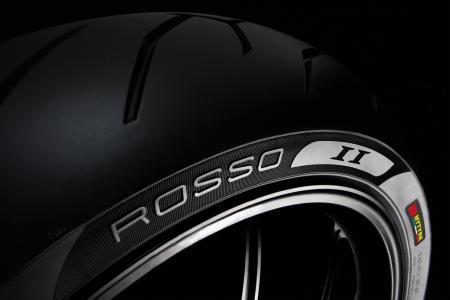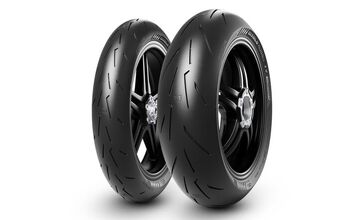Pirelli Diablo Rosso II Review
Anyone who rides a sportbike wants secure, trustworthy grip from their tires. But, and here’s the conundrum, we also want them to last at least as long as an oil change.
Enter the Diablo Rosso II, an evolution of Pirelli’s well-received Diablo Rosso. Relative to its progenitor that debuted in 2008 ( reviewed here), the DR II is said to offer more grip, better mileage, and improved performance in wet conditions.
To put these impressive claims to the test, Pirelli invited us to Utah for a street and track sampling of the Diablo Rosso II, and we came away suitably impressed. The Rosso IIs are said to have a 70/30 balance in street/track use and are positioned between the newish Diablo Rosso Corsa ( reviewed here) and the Angel ST.
The Diablo Rosso II’s rear tire is derived from the original Diablo Rosso, but it now uses dual compounds and a reduced amount of tread grooves. The middle 75% of the rear tire uses high-molecular-weight reactive polymers for good stability and mileage. The 12.5% of the rear tire’s edges are a softer, grippier compound borrowed from the Rosso Corsa’s center rubber. In comparison, the racier Rosso Corsa version has the outer 25% of its rear tire in the softer compound used in the Diablo Supercorsa and shared with the FIM World Superstock SC2 compound.
The Rosso II’s front tire uses a single compound, a variation of what’s used in the Rosso Corsa, featuring a new tread design, a new polymer structure and an optimized silica-to-carbon-black ratio. Its land/sea ratio has increased (i.e. less grooves) by 2% versus the old Diablo Rosso. Wet grip is optimized by new developments in the tread’s shape and inclination, plus its Extreme Cohesive Compound (ECC) that is said to have the optimum balance between chemical grip and water drainage.
Street Testing
First off was a street ride that wended its way from Salt Lake City to Miller Motorsports Park. Staring at me in the parking lot was Ducati’s wild Diavel, the badass muscle cruiser I had yet to sample. ( Read Pete’s review here.) It was the first production bike to be fitted with Pirelli’s new IIs, so I was anxious to feel how it handled with its fat 240/45-17 rear tire.
Pirelli chose an unusually tall 45-series meat for the 240mm-wide Diavel tire, which is in contrast to more typical fat cruiser tires like the 240/40-18 on Harley’s Rocker. Although the Diavel looks big and ungainly in some photos, it actually turns in much easier than anticipated thanks to the tall rear Rosso. In terms of handling quirks, the Diavel requires slightly more inside bar pressure when halfway leaned over to keep it angling steeper through a corner, but overall the Diavel feels more like a large Monster than any cruiser. It’s a riot to ride and one of the best stoplight-to-stoplight racers ever!
Miller Motorsports Park
MMP is mostly flat, but its lack of reference points and mix of fast, sweeping corners makes it technically challenging. Carlos Checa, the dominant force in World Superbikes at the Utah track, describes it as a finesse circuit.
We had a chance at the track to sit down with Stefania Masciullo, the Rosso II’s R&D platform manager, who explained why this new street tire works well on a racetrack. “Traditionally, tires with full silica tire compounds suffer drastically degraded performance once heated to high temperatures,” she told us, referring to racetrack abuse. “But,” she says “the new silica Pirelli developed bonds with the tire’s elastomer polymer and not just with itself, resulting in improved durability when hot.”
Eager to delve into Pirelli’s claims, I jumped on a Yamaha R6 to feel out the Rosso IIs and learn a new race circuit. Although I set off on a set of unscuffed rubber, I was dragging knee after just one slowish sighting lap. The racy Yamaha middleweight performed well on the new Rossos, in this case with a 180mm rear, turning into corners very predictably. Traction was plentiful for a street tire, having enough grip while leaned over to satisfy even quick trackday riders.
Next up was Honda’s CBR1000RR, one of our all-time favorite literbikes because of its midrange-heavy motor and lithe handling. The new Pirellis, here with a 190mm rear tire, surprised with their ample grip and feedback – these are street tires, after all. Turn-in response was sharp and linear, and I was impressed to be able to lean far enough over to drag the CBR’s footpegs without fear of losing traction.
And here’s why the Diablo Rosso IIs make a lot of sense for sportbike riders. It’s a tire that’s grippy enough to drag a CBR’s footpeg on the track, yet it warms up quicker and lasts far longer than a race-compound tire, plus it’ll have much better traction in the wet.
I’ve met a lot of riders over the years who like to mount race-compound tires on their sportbikes because they want the best possible grip. But race tires are expensive, wear quickly, and take much longer to heat up at street speeds. And they’re almost useless in the rain.
Meanwhile, the Diablo Rosso IIs deliver quick warm-up and wet-weather capability while being able to get around a racetrack faster than you probably can. Are your CBR’s pegs worn down, really?
The Diablo Rosso IIs also seem to have terrific durability. I did a nearly 40-minute stint on the CBR during a long track session and didn’t notice a drop in performance, just as Ms. Masciullo said. Pirelli says to expect about 8000 miles out of the front tire, 5000 from the rear – about 10% more than the old Rosso. After nearly four hours of near-continuous use at the track, the tires still looked amazingly fresh and ready for another trackday.
We’re not the only magazine that was impressed with the new Pirellis. Germany’s Motorrad performed a tire comparison test at a racetrack in southern Europe, evaluating road, track and wet capabilities with an ABS-equipped Honda CBR600RR. The Diablo Rosso IIs went around the track more than one second faster than its closest competitors, and they were also judged best in street performance.
Selecting which Pirelli Diablo is ideal for you might be contentious. I became a believer of the Diablo Rosso Corsa when I tested it at the Assen TT circuit in the Netherlands, and they remain one of my favorite sportbike tires. Pirelli says the Diablo Rosso IIs have much better wet traction and mileage than the Rosso Corsa but less ultimate grip. The Rosso Corsa is a better choice for trackdays, but the versatility and better mileage of the Rosso II makes it a better compromise for use on the street.
So, where do you ride most? For more details, check out http://www.pirelli.com/.
Related Reading
Pirelli Diablo Rosso Corsa Tire Review
Pirelli Diablo Rosso Review
Pirelli Angel ST Tire Review
Metzeler Sportec M5 Review
Dunlop Sportmax Roadsmart II Review
More by Kevin Duke



































Comments
Join the conversation